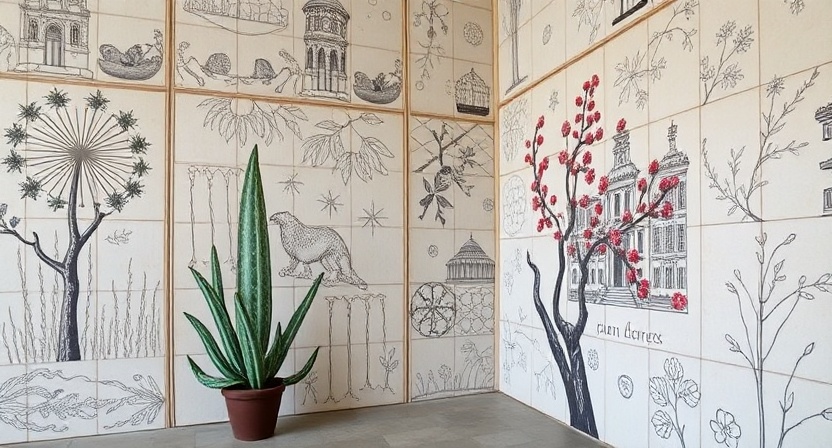Interior design has evolved beyond standard materials and conventional surfaces, emphasizing personalization and artistic expression. Every element in a space contributes to its character, making creative customization essential for both residential and commercial environments. Tiles have long been valued for their durability, practicality, and ease of maintenance, but traditional designs often limit creativity. Modern spaces require solutions that offer both functionality and unique aesthetic appeal, allowing homeowners and designers to leave a lasting impression.
Ceramic printing has emerged as a revolutionary technique in this context. By applying intricate designs, patterns, or photographic images directly onto ceramic surfaces, ceramic printing enables spaces to reflect individual style and creativity. This method offers vibrant, precise, and long-lasting results, making it ideal for interior décor, artistic projects, and commercial applications where durability and visual appeal are equally important.
How Ceramic Printing Works?
Ceramic printing involves transferring designs onto ceramic surfaces using digital, UV, or sublimation printing techniques. Unlike traditional painting or decal methods, ceramic printing ensures high accuracy, consistent results, and vivid color reproduction. Complex patterns, gradients, and even photographic images can be applied with remarkable precision, transforming ordinary ceramics into visually striking design elements.
Benefits of Ceramic Printing
Personalized Design Options
One of the key advantages of ceramic printing is the ability to fully customize designs. Whether creating detailed murals, minimalistic patterns, or abstract artwork, this technology allows homeowners and designers to achieve a unique and cohesive look tailored to any space.
Durability and Longevity
Printed ceramics maintain their quality for years. The inks and coatings used in ceramic printing resist fading, scratching, and exposure to moisture, ensuring long-lasting visual appeal. This makes it suitable for high-traffic areas like kitchens, bathrooms, and commercial spaces.
Versatility Across Applications
Ceramic printing is not limited to tiles and walls. It can enhance countertops, furniture surfaces, decorative panels, and even large-scale art installations. This versatility provides endless opportunities for creative interior solutions.
Cost-Effective Customization
Compared to hand-painted or specialty ceramics, ceramic printing is more efficient and cost-effective. Large quantities of personalized items can be produced without sacrificing quality, making it suitable for both small-scale and large-scale projects.
Applications of Ceramic Printing
Residential Interiors
Homeowners can use ceramic printing to create feature walls, kitchen backsplashes, bathroom tiles, and decorative accents. Personalized designs allow spaces to reflect personality, creating a distinctive atmosphere in any room.
Commercial Spaces
Businesses such as restaurants, hotels, offices, and retail stores can leverage ceramic printing to showcase branding, thematic visuals, or custom decorative patterns. This approach strengthens brand identity and enhances the overall aesthetic appeal of commercial interiors.
Artistic Projects
Artists and designers can experiment with large-scale murals, exhibition panels, and public installations. Ceramic printing offers precise detailing and durability, making it ideal for both indoor and outdoor art projects.
Tips for Successful Ceramic Printing
Plan the Design Carefully
Visualizing the final layout ensures consistency and coherence. Consider color schemes, patterns, and the interaction between tiles and surrounding elements for the best outcome.
Ensure Accurate Tile Placement
Large designs or continuous patterns require careful alignment. Proper placement prevents misalignment, producing a seamless and professional appearance.
Use High-Quality Materials
Select ceramic tiles compatible with digital, UV, or sublimation printing to achieve the best results. Consider factors such as finish, durability, and environmental conditions when choosing materials.
Balance Aesthetic Appeal and Functionality
While creating visually stunning tiles is important, consider practical factors such as slip resistance, heat tolerance, and overall durability to ensure a functional and attractive space.
Future Trends in Ceramic Printing
Technological advancements continue to expand the possibilities of ceramic printing. Innovations such as eco-friendly inks, larger format printing, and textured surfaces are increasing design flexibility. Customization for personal or commercial projects is becoming more accessible, allowing creativity to flourish in interior design and decorative applications.
Conclusion
Ceramic printing is a transformative solution for modern interiors, combining creativity, durability, and versatility. It allows homeowners, designers, and businesses to produce unique, long-lasting, and visually captivating tiles, tableware, and decorative elements. With careful planning, quality materials, and professional execution, ceramic printing ensures that every project achieves both aesthetic excellence and functional performance, making it an essential tool for contemporary design.





Comments